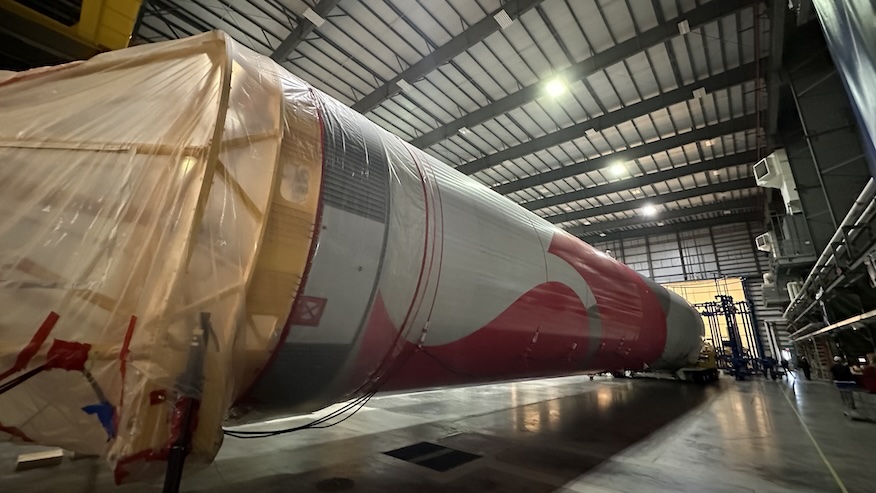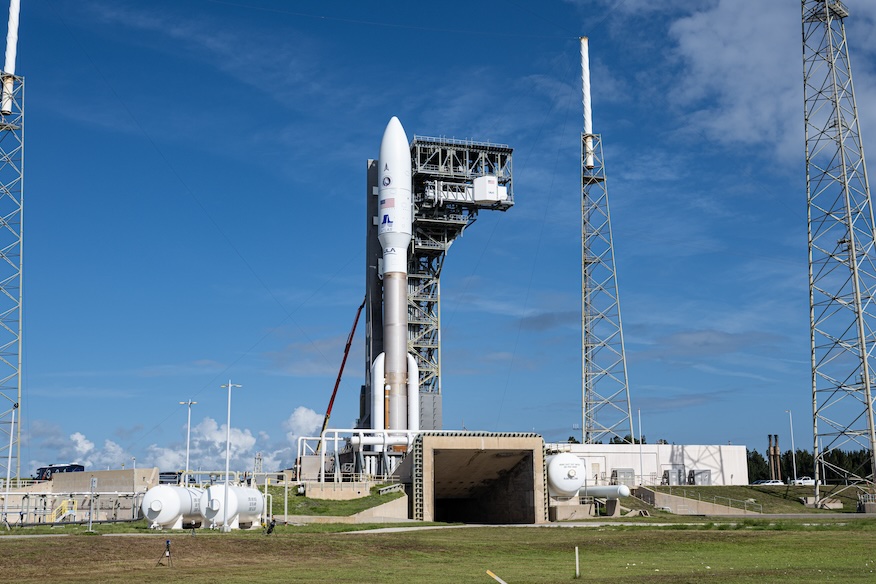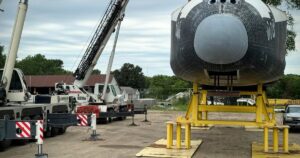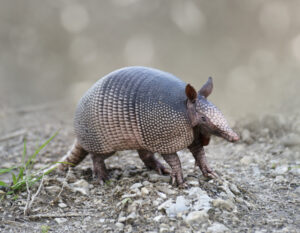United Launch Alliance’s Atlas 5 rocket is gearing up for its swan song when it comes to launching critical US national security missions. The launch carrier is preparing to send a classified payload as part of United States Space Force mission-51 (USSF-51), marking the 100th such operation for ULA.
Liftoff from Space Launch Complex 41 (SLC-41) at the Cape Canaveral Space Force Station (CCSFS) is targeted for Tuesday, July 30, during a three-hour window that opens at 6:45 a.m. EDT (1045 UTC). Spaceflight Now will have live coverage starting almost two hours before liftoff.
Of the 99 national security flights so far, ULA has used an Atlas 5 rocket for 57 of them. This partnership between the rocket and the Department of Defense dates back to the first such mission, Space Test Program 1 (STP-1), which launched in March 2007.
These national security missions were originally contracted under the Evolved Expendable Launch Vehicle (EELV) program. The program’s name changed to National Security Space Launch (NSSL) in March 2019, about nine months before the creation of the US Space Force.
“The next five missions, starting with this one, were national security space launch missions and were the forging of a tremendous partnership with United Launch Alliance that continues to this day,” said Dr. Walt Lauderdale, USSF-51 mission director.
“We’ve put a lot of national capabilities into orbit to support our warfighter and our intelligence communities, capabilities that we can’t exceed in some areas to speak of, but things that help our people at sea, in the air and on the ground around the globe every day.”
ULA spent much of the day Saturday rolling the Atlas 5 rocket from its Vertical Integration Facility, making its final one-third-of-a-mile (550-meter) trip to the launch pad at SLC-41. It came after ULA Launch Director Steve Huff led and completed a launch readiness review on Friday.
“This is the last Space Force Atlas 5 launch, and it’s one of the most critical payloads we’ve put up to date, I would say,” said Gary Wentz, ULA’s vice president for government and commercial programs. “We can’t talk much about it, but it’s definitely critical to the defense of our nation as well as our allies.”
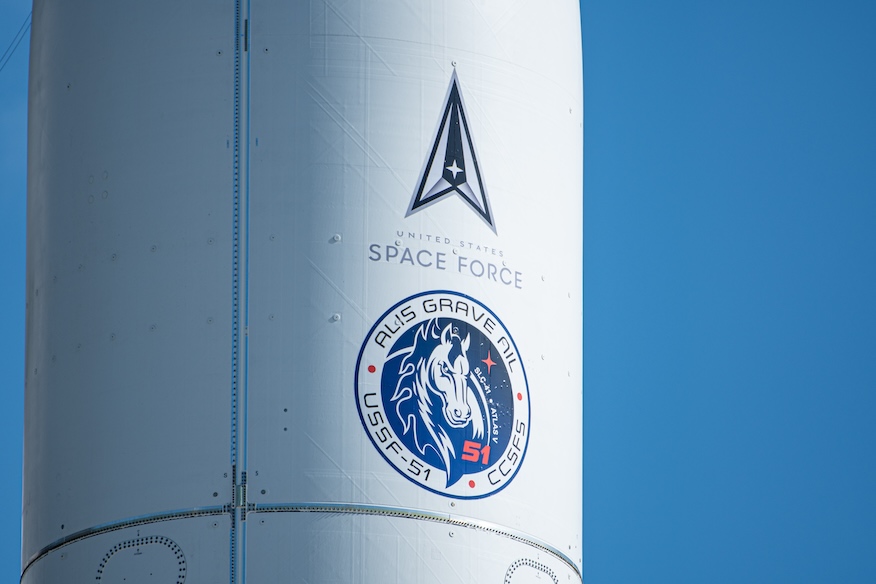
The USSF-51 mission was assigned to ULA as part of the NSSL Phase 2 Order Year 1 assignment. ULA and SpaceX were awarded $3.4 billion and $3.3 billion Indefinite Delivery Requirements (IDR) contracts in May 2019. to launch approximately 34 missions split 60/40.
Earlier this month, a contract amendment was announced to “increase the estimated total dollar value of the contact due to the increase in expected mission quantities to be ordered under the Phase 2 contract.”
“In accordance with DFARS 205.303, a public announcement must be made after the initial estimated face value is reached. The government placed a bona fide manifesto evaluation in the Phase 2 request for proposals published in May 2019 to allow potential applicants to adequately develop their proposals,” a spokesperson for the US Space Systems Command told Spaceflight Now in a July 19 statement . “We estimated that 34 missions would be ordered during Phase 2, and the 34 missions (split 60/40) were used to develop contract values for ULA and SpaceX of $3.4 billion and $3.3 billion, respectively. “
“Since FY24 is the final Phase 2 order year, this modification updates the contracts to the actual number of missions ordered for FY20-24 to 49 and thus the need to increase the contract value to 4.5 billion and 4 .0 billion dollars.”
The 49th mission, NROL-95, is expected to be assigned by the end of July, according to the SSC.
USSF-51 was originally scheduled to launch with a Vulcan rocket, but due to development delays in June 2021, the US Space and Missile Systems Center (renamed SSC in 2021) approved switching the launch vehicle from Vulcan to Atlas .
“The Bruiser” era.
While neither ULA nor the US Space Force offered details about the mission, it refers to what ULA calls “the highest performance configuration of the (Atlas) rocket with a full compliment of five solid rocket boosters.” ULA referred to this as the Atlas 5 551 configuration, or as ULA President and CEO Tory Bruno called it, “The Bruiser.”
This version of the Atlas 5 rocket will be seen several more times before the rocket is finally retired. Wentz told Spaceflight Now on Saturday that all remaining commercial launches will fly the 551 configuration, which includes eight missions for Amazon’s Kuiper project and one for Viasat.
“You learn a lot every time you fly, and we’re flying five GEM (graphite-epoxy motor) 63s on this mission,” Wentz said. “So we’ll learn from that, continue to get data and apply that to future Atlas missions going forward.”
Prior to the launch of USSF-51, ULA had launched 13 previous missions using the 551 configuration. ULA first flew an Atlas 5 551 rocket on January 19, 2006, when it launched NASA’s New Horizons mission to Pluto. It was the seventh launch of an Atlas 5 rocket overall.
“The Bruiser” version of Atlas 5 also launches the following missions:
- August 5, 2011 – Juno
- February 24, 2012 – MUOS-1
- July 19, 2013 – MUOS-2
- January 20, 2014 – MUOS-3
- September 2, 2015 – MUOS-4
- June 24, 2016 – MUOS-5
- April 14, 2018 – AFSPC-11
- 17 October 2018 – AEHF-4
- August 8, 2019 – AEHF-5
- March 26, 2020 – AEHF-6
- December 7, 2021 – STP-3
- September 10, 2023 – NROL-107
“The team goes through, models, predicts performance. They will then go over all the flight characteristics, what the mission needs and what reserves we have. Then when we get down here, the team goes through the painstaking details, stacking the booster, bonding the solids, the upper stage, integrating the payload,” Wentz said. “They just continually focus on the safety of not only the hardware, but our personnel throughout the process to achieve 100 percent mission success.”
Volcanoes on the horizon
With the USSF-51 mission in the rearview mirror for ULA, it will shift its focus to Vulcan’s second certification flight, known as Cert-2. Its first launch, Cert-1, proved successful in January when it launched the Astrobotic Peregrine lunar rover.
ULA is aiming for the second launch to take place in September with an inert payload on board, which will include some demonstrations of Vulcan technology.
“We are in the final phase of our certification. ULA is completing its final qualification tests, which are going well, and we’re ready to be done and waiting for data from this next certification flight, and then we’re ready for our first national security mass acceptance in October,” said Col. Jim Horn, senior manager of the Launch Execution Delta outfit.
“Things are going well. We’ve had a lot of good feedback, we’ve overcome some big hurdles, and we’re excited to continue this year.”
In recent weeks, Bruno has shared several images of the Vulcan vehicle’s progress, stating in a post on X, formerly Twitter, that there are currently “23 Vulcans in production!!!”
Another #Vulcan rocket leaves Alabama and heads to Florida, freeing up space in our crowded rocket factory. 23 Vulcans in production!!! pic.twitter.com/CIfBl8yKMS
— Tory Bruno (@torybruno) July 26, 2024
That exclamation punctuated the third Vulcan booster that left the ULA factory in Decatur, Ala., to begin the trip to Florida. It will support the USSF-87 mission, which will launch in late 2024.
Vulcan’s first operational mission will be the USSF-106 mission that Horn mentioned. Before that happens, Horn said he and others are eager to watch the Cert-2 mission perform.
Cert-2 was originally intended to launch Sierra Space’s Dream Chaser spacecraft, but because it fell behind schedule in its final, pre-launch mission, ULA and Sierra Space decided to move that mission to another launch to go through the certification process.
“At that point, the data (from Cert-1) correlated pretty closely with our model. So this is just another verification that we have the right analysis tools for future flights and we’re sure we’ve captured the environment for the spacecraft as well as the rocket,” Horn said.
“It will be a really good validation for us of what we saw in Cert-1. The configuration differences were well within our certification plan. Based on that, they just had to make some adjustments for this mission. But we’re excited to get the data.
